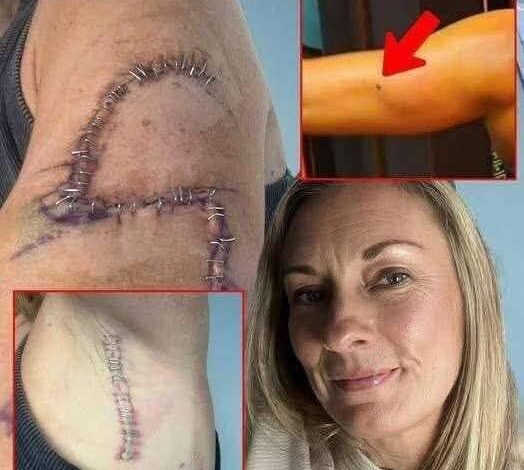Early Skin Cancer Detection: One Woman’s Journey from Ignored Warning Signs to Life-Saving Treatment

When regular skin monitoring becomes a life-saving habit: A 34-year-old professional’s experience highlights the critical importance of dermatological awareness and early medical intervention.
The Overlooked Warning Signs
Sarah Mitchell, a 34-year-old marketing professional from Oregon, initially dismissed what appeared to be an ordinary skin lesion on her shoulder. As a busy working mother managing her career and family responsibilities, she had little time for detailed self-examination of minor skin changes.
The small, brown mark had appeared approximately twelve months earlier and seemed unremarkable among the numerous other moles scattered across her body—many of which had been present since her adolescence. Without causing discomfort or obvious concern, the lesion initially resembled what many people might assume to be a simple age spot or sun damage.
Gradual Changes That Demanded Attention
Over several months, subtle but significant transformations began occurring. The previously flat lesion started becoming slightly elevated, its borders became increasingly irregular, and intermittent itching developed. Despite these changes, Sarah attributed the symptoms to common skin irritation caused by clothing friction—a reasonable assumption that many people make when experiencing similar symptoms.
The Medical Reality: 77 Stitches and a Diagnosis
When Sarah finally consulted with dermatology specialists, the medical evaluation revealed a serious condition requiring immediate surgical intervention. The procedure ultimately required 77 stitches and led to a diagnosis that would fundamentally change her approach to skin health monitoring.
Critical Skin Health Awareness Guidelines
Dermatologists emphasize several key warning signs that should prompt immediate medical consultation:
The ABCDE Method for Skin Examination:
- Asymmetry: One half doesn’t match the other
- Border irregularity: Edges are ragged or blurred
- Color variation: Multiple colors or uneven pigmentation
- Diameter: Larger than 6mm (pencil eraser size)
- Evolution: Changes in size, shape, color, or symptoms
High-Risk Factors for Skin Cancer:
- Excessive sun exposure without protection
- History of sunburns, especially during childhood
- Fair skin complexion and light eye color
- Family history of skin cancer
- Numerous moles or unusual mole patterns
- Weakened immune system
The Importance of Professional Skin Screening
Regular dermatological examinations can detect potentially dangerous skin conditions in their earliest, most treatable stages. Medical professionals recommend annual skin checks for most adults, with more frequent monitoring for individuals with elevated risk factors.
Early detection statistics demonstrate remarkable treatment success rates:
- Stage 1 skin cancer has a 5-year survival rate exceeding 95%
- Advanced stages show significantly lower survival rates
- Professional screening can identify concerning changes before they become visible to untrained eyes
Preventive Measures for Optimal Skin Health
Sun Protection Strategies:
- Daily application of broad-spectrum SPF 30+ sunscreen
- Protective clothing and wide-brimmed hats during outdoor activities
- Seeking shade during peak UV hours (10 AM to 4 PM)
- Avoiding intentional tanning and tanning bed usage
Monthly Self-Examination Protocol:
- Systematic inspection of all skin surfaces using mirrors
- Documentation of existing moles with photographs
- Immediate medical consultation for any concerning changes
- Partner assistance for hard-to-see areas
The Life-Changing Impact of Early Intervention
Sarah’s experience illustrates how seemingly minor skin changes can represent serious medical conditions requiring prompt professional evaluation. Her story serves as a powerful reminder that busy lifestyles shouldn’t prevent regular health monitoring and timely medical consultations.
Key Takeaways for Skin Health Management:
- Never ignore persistent changes in existing moles
- Schedule regular dermatological screenings
- Maintain consistent sun protection habits
- Perform monthly self-examinations
- Seek immediate medical attention for concerning symptoms
Professional Medical Guidance
Individual risk factors and symptoms vary significantly among patients. Anyone noticing unusual skin changes should consult with qualified dermatologists or healthcare providers for personalized evaluation and treatment recommendations.
This article provides general health information and should not replace professional medical advice. Always consult with qualified healthcare providers for diagnosis and treatment of specific medical conditions.